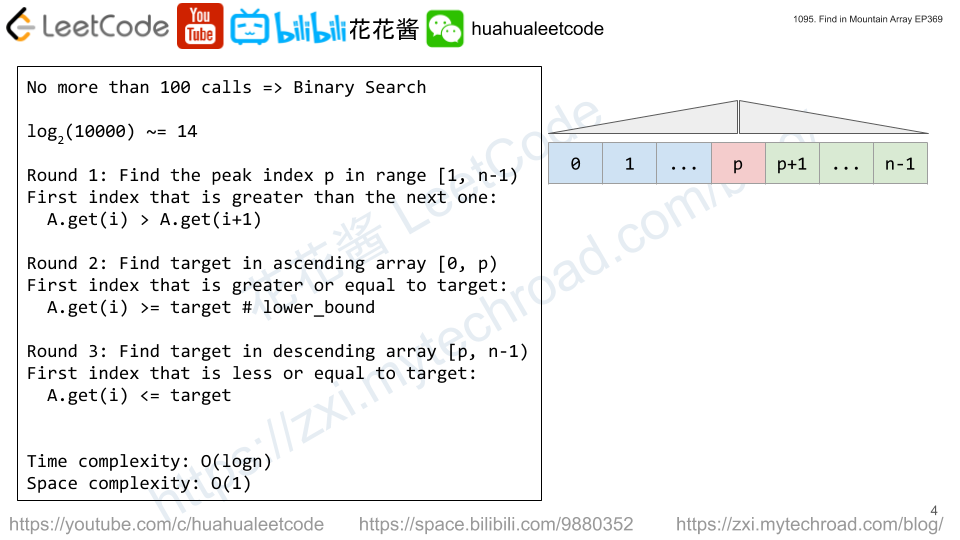A split of an integer array is good if:
- The array is split into three non-empty contiguous subarrays – named
left,mid,rightrespectively from left to right. - The sum of the elements in
leftis less than or equal to the sum of the elements inmid, and the sum of the elements inmidis less than or equal to the sum of the elements inright.
Given nums, an array of non-negative integers, return the number of good ways to split nums. As the number may be too large, return it modulo 109 + 7.
Example 1:
Input: nums = [1,1,1] Output: 1 Explanation: The only good way to split nums is [1] [1] [1].
Example 2:
Input: nums = [1,2,2,2,5,0] Output: 3 Explanation: There are three good ways of splitting nums: [1] [2] [2,2,5,0] [1] [2,2] [2,5,0] [1,2] [2,2] [5,0]
Example 3:
Input: nums = [3,2,1] Output: 0 Explanation: There is no good way to split nums.
Constraints:
3 <= nums.length <= 1050 <= nums[i] <= 104
Solution 1: Prefix Sum + Binary Search
We split the array into [0 … i] [i + 1… j] [j + 1 … n – 1]
we can use binary search to find the min and max of j for each i.
s.t. sum(0 ~ i) <= sums(i + 1 ~j) <= sums(j + 1 ~ n – 1)
min is lower_bound(2 * sums(0 ~ i))
max is upper_bound(sums(0 ~ i) + (total – sums(0 ~ i)) / 2)
Time complexity: O(nlogn)
Space complexity: O(1)
C++
|
1 2 3 4 5 6 7 8 9 10 11 12 13 14 15 16 17 18 19 20 |
// Author: Huahua class Solution { public: int waysToSplit(vector<int>& nums) { constexpr int kMod = 1e9 + 7; const int n = nums.size(); for (int i = 1; i < n; ++i) nums[i] += nums[i - 1]; const int total = nums.back(); long ans = 0; // [0 .. i] [i + 1 ... j] [j + 1 ... n - 1] for (int i = 0, left = 0; i < n; ++i) { auto it1 = lower_bound(begin(nums) + i + 1, end(nums), 2 * nums[i]); auto it2 = upper_bound(begin(nums), end(nums) - 1, nums[i] + (total - nums[i]) / 2); if (it2 <= it1) continue; ans += it2 - it1; } return ans % kMod; } }; |
Solution 2: Prefix Sum + Two Pointers
The right end of the middle array is in range [j, k – 1] and there are k – j choices.
Time complexity: O(n)
Space complexity: O(1)
C++
|
1 2 3 4 5 6 7 8 9 10 11 12 13 14 15 16 17 18 19 20 |
// Author: Huahua class Solution { public: int waysToSplit(vector<int>& nums) { constexpr int kMod = 1e9 + 7; const int n = nums.size(); for (int i = 1; i < n; ++i) nums[i] += nums[i - 1]; const int total = nums.back(); long ans = 0; for (int i = 0, j = 0, k = 0; i < n; ++i) { j = max(j, i + 1); while (j < n - 1 && nums[j] < 2 * nums[i]) ++j; k = max(k, j); while (k < n - 1 && 2 * nums[k] <= nums[i] + total) ++k; ans += (k - j); } return ans % kMod; } }; |
